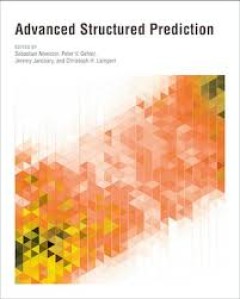Filter by

Advanced Structured Prediction
The goal of structured prediction is to build machine learning models that predict relational information that itself has structure, such as being composed of multiple interrelated parts. These models, which reflect prior knowledge, task-specific relations, and constraints, are used in fields including computer vision, speech recognition, natural language processing, and computational biology. …
- Edition
- -
- ISBN/ISSN
- 0262322951
- Collation
- 1 online resource (ix, 415 pages) :illustrations.
- Series Title
- -
- Call Number
- -

The AI playbook :mastering the rare art of machine learning deployment
"A playbook for bridging business and data science worlds to effectively execute machine learning projects in business"--OCLC-licensed vendor bibliographic record.
- Edition
- -
- ISBN/ISSN
- 9780262378123
- Collation
- 1 online resource.
- Series Title
- -
- Call Number
- -

Art in the age of machine learning
"This book examines artistic practices that use machine learning and computational technologies through historical perspectives surrounding adaptive systems from the 1950s onwards"--OCLC-licensed vendor bibliographic record.
- Edition
- -
- ISBN/ISSN
- 0262367092
- Collation
- 1 online resource.
- Series Title
- -
- Call Number
- -

How to grow a robot: :developing human-friendly, social AI
"Mark Lee considers that the current gains in machine learning and deep learning will not produce robots that can interact effectively with humans. The book then explores how robots can become more human-like, more general-purpose, and more social. The book introduces us to the core ideas in Developmental Robotics - showing how this new approach can "grow" robots through (their own) experience …
- Edition
- -
- ISBN/ISSN
- 0262357852
- Collation
- 1 online resource.
- Series Title
- -
- Call Number
- -

Predicting structured data
Collected papers based on talks presented at two Neural Information Processing Systems workshops.State-of-the-art algorithms and theory in a novel domain of machine learning, prediction when the output has structure.Machine learning develops intelligent computer systems that are able to generalize from previously seen examples. A new domain of machine learning, in which the prediction must sati…
- Edition
- -
- ISBN/ISSN
- 9780262255691
- Collation
- 1 online resource (viii, 348 pages) :illustrations.
- Series Title
- -
- Call Number
- -

Large-scale kernel machines
Pervasive and networked computers have dramatically reduced the cost of collecting and distributing large datasets. In this context, machine learning algorithms that scale poorly could simply become irrelevant. We need learning algorithms that scale linearly with the volume of the data while maintaining enough statistical efficiency to outperform algorithms that simply process a random subset o…
- Edition
- -
- ISBN/ISSN
- 0262255790
- Collation
- 1 online resource (xii, 396 pages) :illustrations.
- Series Title
- -
- Call Number
- -

Learning with kernels :support vector machines, regularization, optimization,…
In the 1990s, a new type of learning algorithm was developed, based on results from statistical learning theory: the Support Vector Machine (SVM). This gave rise to a new class of theoretically elegant learning machines that use a central concept of SVMs -- -kernels--for a number of learning tasks. Kernel machines provide a modular framework that can be adapted to different tasks and domains by…
- Edition
- -
- ISBN/ISSN
- 9780262256933
- Collation
- 1 online resource (xviii, 626 pages) :illustrations.
- Series Title
- -
- Call Number
- -

Learning kernel classifiers :theory and algorithms
Linear classifiers in kernel spaces have emerged as a major topic within the field of machine learning. The kernel technique takes the linear classifier--a limited, but well-established and comprehensively studied model--and extends its applicability to a wide range of nonlinear pattern-recognition tasks such as natural language processing, machine vision, and biological sequence analysis. This…
- Edition
- -
- ISBN/ISSN
- 9780262256339
- Collation
- 1 online resource (xx, 364 pages) :illustrations.
- Series Title
- -
- Call Number
- -

Robot shaping :an experiment in behavior engineering
"A Bradford book."Foreword by Lashon BookerTo program an autonomous robot to act reliably in a dynamic environment is a complex task. The dynamics of the environment are unpredictable, and the robots' sensors provide noisy input. A learning autonomous robot, one that can acquire knowledge through interaction with its environment and then adapt its behavior, greatly simplifies the designer's wor…
- Edition
- -
- ISBN/ISSN
- 0585031037
- Collation
- 1 online resource (xviii, 203 pages) :illustrations.
- Series Title
- -
- Call Number
- -
 Computer Science, Information & General Works
Computer Science, Information & General Works  Philosophy & Psychology
Philosophy & Psychology  Religion
Religion  Social Sciences
Social Sciences  Language
Language  Pure Science
Pure Science  Applied Sciences
Applied Sciences  Art & Recreation
Art & Recreation  Literature
Literature  History & Geography
History & Geography